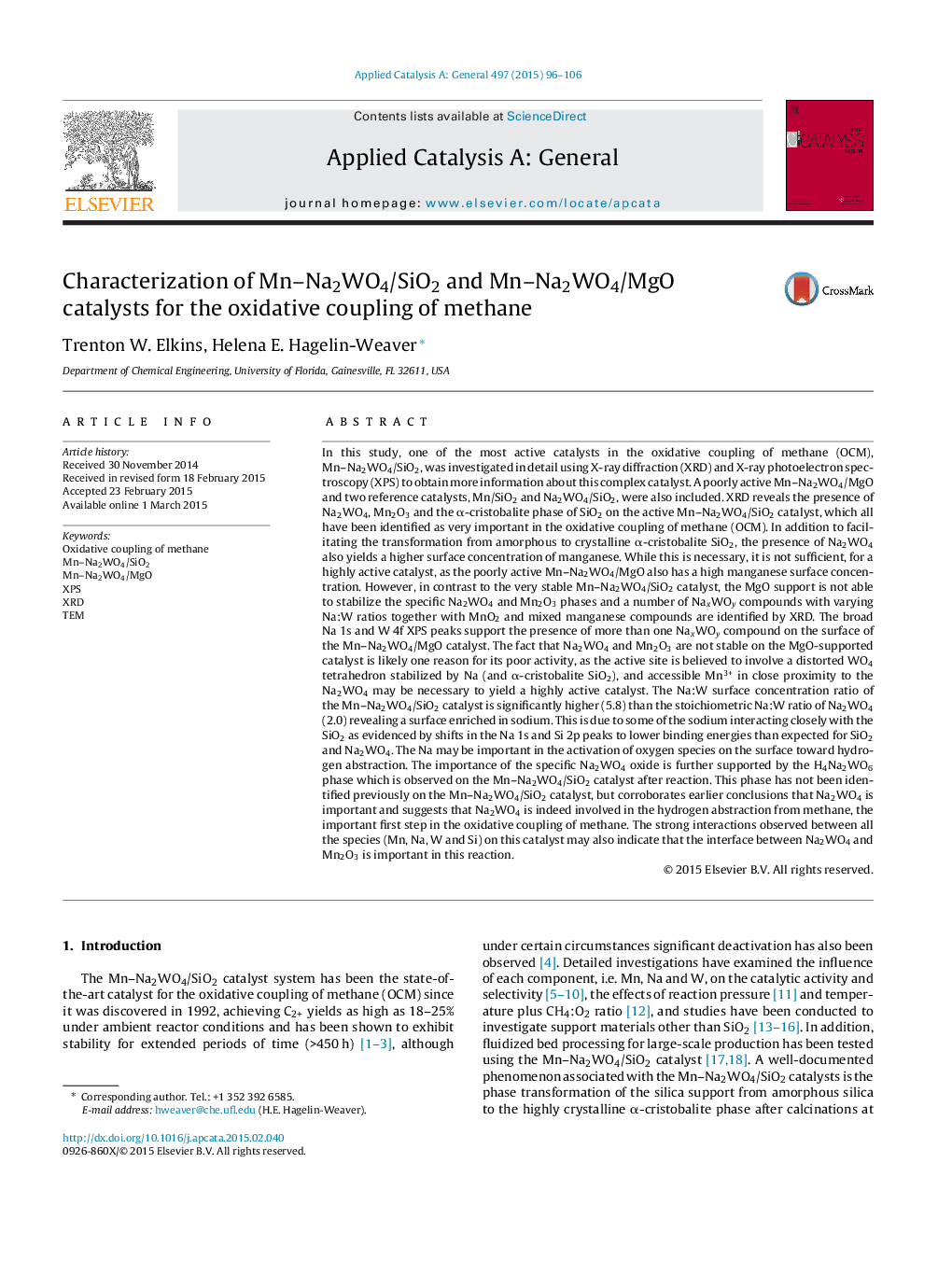| Article ID | Journal | Published Year | Pages | File Type |
|---|---|---|---|---|
| 39278 | Applied Catalysis A: General | 2015 | 11 Pages |
•Characterization of SiO2- and MgO-supported Mn–Na2WO4 methane-coupling catalysts.•MgO-supported catalysts not stable and form several mixed oxides.•Na-enriched α-cristobalite SiO2 stabilizes two important phases Mn2O3 and NaWO4.•Mn2O3 phase needed for high activity and NaWO4 yields superior selectivity.•The H2NaWO6 identified on Mn–Na2WO4/SiO2 confirms importance of NaWO4.
In this study, one of the most active catalysts in the oxidative coupling of methane (OCM), Mn–Na2WO4/SiO2, was investigated in detail using X-ray diffraction (XRD) and X-ray photoelectron spectroscopy (XPS) to obtain more information about this complex catalyst. A poorly active Mn–Na2WO4/MgO and two reference catalysts, Mn/SiO2 and Na2WO4/SiO2, were also included. XRD reveals the presence of Na2WO4, Mn2O3 and the α-cristobalite phase of SiO2 on the active Mn–Na2WO4/SiO2 catalyst, which all have been identified as very important in the oxidative coupling of methane (OCM). In addition to facilitating the transformation from amorphous to crystalline α-cristobalite SiO2, the presence of Na2WO4 also yields a higher surface concentration of manganese. While this is necessary, it is not sufficient, for a highly active catalyst, as the poorly active Mn–Na2WO4/MgO also has a high manganese surface concentration. However, in contrast to the very stable Mn–Na2WO4/SiO2 catalyst, the MgO support is not able to stabilize the specific Na2WO4 and Mn2O3 phases and a number of NaxWOy compounds with varying Na:W ratios together with MnO2 and mixed manganese compounds are identified by XRD. The broad Na 1s and W 4f XPS peaks support the presence of more than one NaxWOy compound on the surface of the Mn–Na2WO4/MgO catalyst. The fact that Na2WO4 and Mn2O3 are not stable on the MgO-supported catalyst is likely one reason for its poor activity, as the active site is believed to involve a distorted WO4 tetrahedron stabilized by Na (and α-cristobalite SiO2), and accessible Mn3+ in close proximity to the Na2WO4 may be necessary to yield a highly active catalyst. The Na:W surface concentration ratio of the Mn–Na2WO4/SiO2 catalyst is significantly higher (5.8) than the stoichiometric Na:W ratio of Na2WO4 (2.0) revealing a surface enriched in sodium. This is due to some of the sodium interacting closely with the SiO2 as evidenced by shifts in the Na 1s and Si 2p peaks to lower binding energies than expected for SiO2 and Na2WO4. The Na may be important in the activation of oxygen species on the surface toward hydrogen abstraction. The importance of the specific Na2WO4 oxide is further supported by the H4Na2WO6 phase which is observed on the Mn–Na2WO4/SiO2 catalyst after reaction. This phase has not been identified previously on the Mn–Na2WO4/SiO2 catalyst, but corroborates earlier conclusions that Na2WO4 is important and suggests that Na2WO4 is indeed involved in the hydrogen abstraction from methane, the important first step in the oxidative coupling of methane. The strong interactions observed between all the species (Mn, Na, W and Si) on this catalyst may also indicate that the interface between Na2WO4 and Mn2O3 is important in this reaction.
Graphical abstractFigure optionsDownload full-size imageDownload high-quality image (168 K)Download as PowerPoint slide
